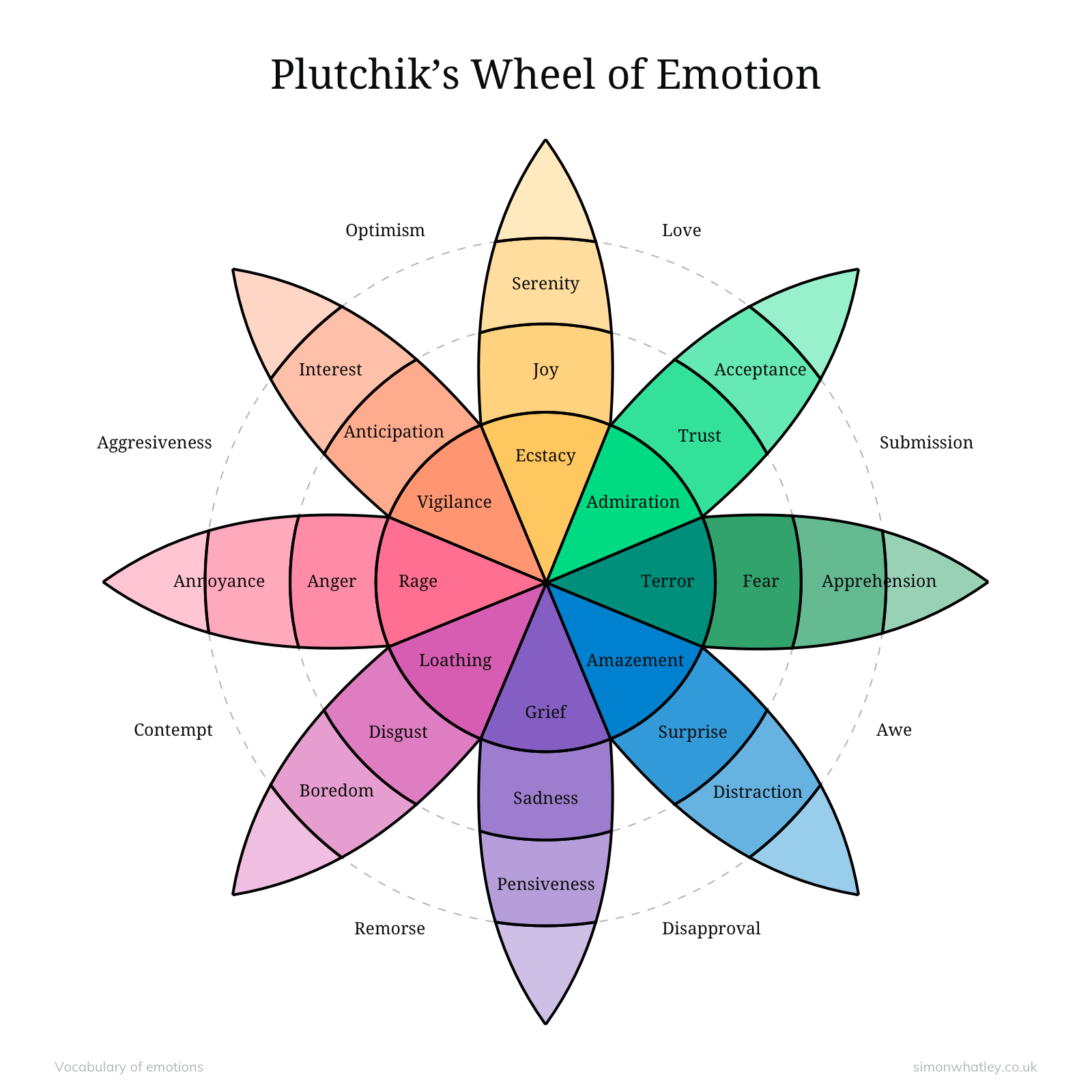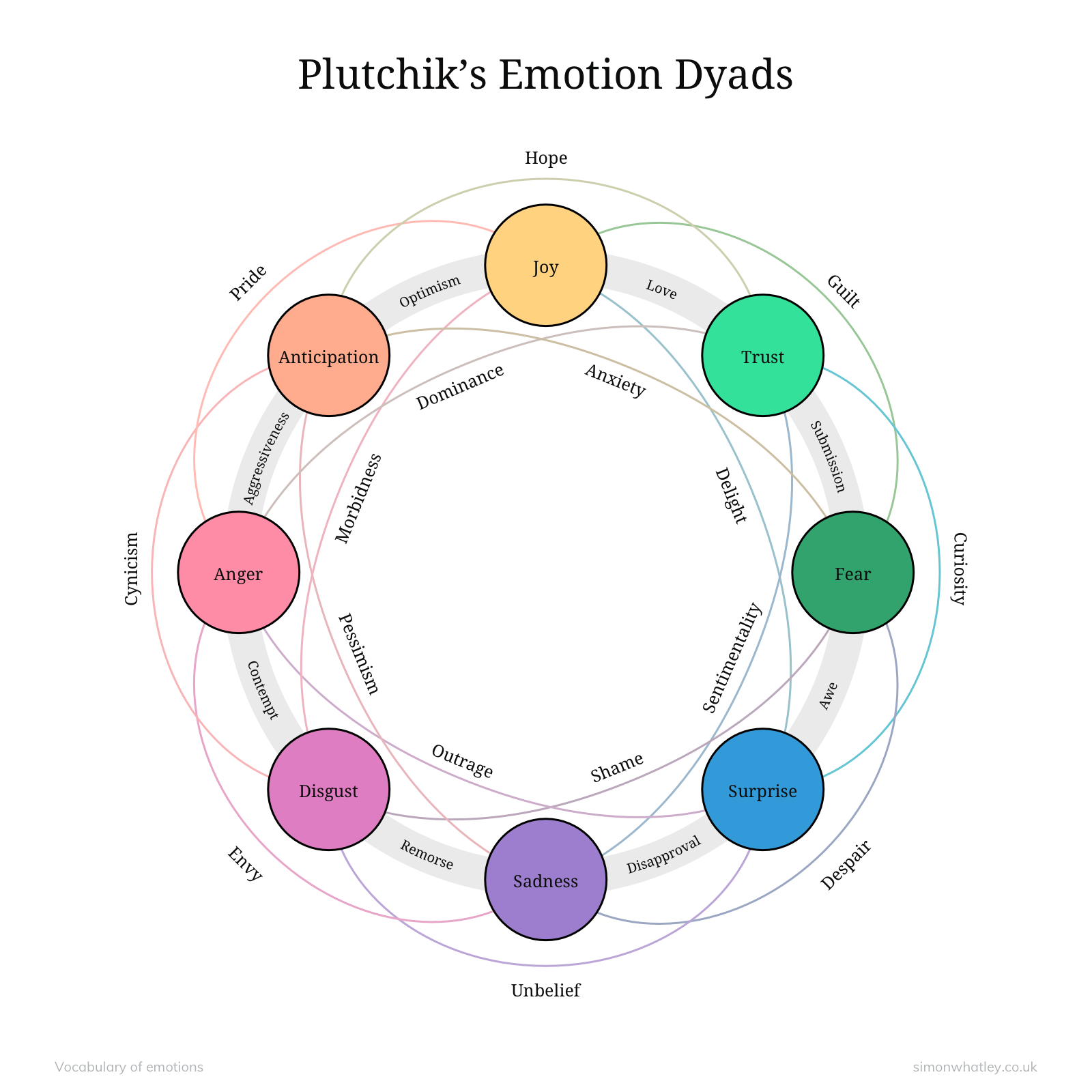Plutchik’s wheel of emotion
This post is part of a series of notes I collated during my studies at UCL’s Interaction Centre (UCLIC).
Pyschologist Robert Plutchik developed one of the most popular classifications of emotion called Plutchik’s wheel of emotion.

Figure 1: Plutchik’s wheel of emotion. Download a copy of the wheel (PDF 38KB)
Plutchik suggested that people experience eight core or primary emotions, which he arranged in opposite pairs on a wheel:
- joy and sadness
- trust and loathing
- fear and anger
- surprise and anticipation
These eight emotions are organised based on the physiological purpose of each.
The wheel is actually a cone that unfolds to the emotion wheel.
According to Plutchik’s theory, these basic emotions can intensify, become milder, or combine to produce a range of emotional states.

Figure 2: Plutchik’s emotion dyads. Download a copy of the dyads (PDF 25KB)
Combining emotionsPermalink to section titled Combining emotions
The eight primary emotions can be combined into twenty-four primary, secondary and tertiary dyads—feelings composed of two emotions.
The combination of emotions can be paired in four groups:
- primary dyads are adjacent or one petal apart, for example love is a combination of joy and trust
- secondary dyads are two petals apart, for example envy is a combination of sadness and anger
- tertiary dyads are three petals apart, for example shame is a combination of fear and disgust
- opposite emotions are four petals apart, for example anticipation is the opposite of surprise
There are also triads—emotions formed from 3 primary emotions. This leads to a combination of 24 dyads and 32 triads, making 56 emotions at 1 intensity level.
Primary dyad combinationsPermalink to section titled Primary dyad combinations
Combining adjacent emotions leads to additional emotional states:
- joy + trust = love (with its opposite being remorse)
- trust + fear = submission (with its opposite being contempt)
- fear + surprise = awe (with its opposite being aggression)
- surprise + sadness = disapproval (with its opposite being optimism)
- sadness + disgust = remorse (with its opposite being love)
- disgust + anger = contempt (with its opposite being submission)
- anger + anticipation = aggressiveness (with its opposite being awe)
- anticipation + joy = optimism (with its opposite being disapproval)
Secondary dyad combinationsPermalink to section titled Secondary dyad combinations
Combining emotions two petals apart leads to the following emotional states:
- joy + fear = guilt (with its opposite being envy)
- trust + surprise = curiosity (with its opposite being cynicism)
- fear + sadness = despair (with its opposite being pride)
- surprise + disgust = unbelief (with its opposite being hope)
- sadness + anger = envy (with its opposite being guilt)
- disgust + anticipation = cynicism (with its opposite being curiosity)
- anger + joy = pride (with its opposite being despair)
- anticipation + trust = hope (with its opposite being unbelief)
Tertiary dyad combinationsPermalink to section titled Tertiary dyad combinations
Combining emotions three petals apart leads to the following emotional states:
- joy + surprise = delight (with its opposite being pessimism)
- trust + sadness = sentimentality (with its opposite being morbidness)
- fear + disgust = shame (with its opposite being dominance)
- surprise + anger = outrage (with its opposite being anxiety)
- sadness + anticipation = pessimism (with its opposite being delight)
- disgust + joy = morbidness (with its opposite being sentimentality)
- anger + trust = dominance (with its opposite being shame)
- anticipation + fear = anxiety (with its opposite being outrage)
Intensity levelsPermalink to section titled Intensity levels
The cone’s vertical dimension represents intensity. On the wheel, emotions intensify towards the centre, which is also indicated by the darkening colour. The darker the shade, the more intense the emotion. For example, joy at its least intense is serenity and at its most intense is ecstasy. Similarly, anger at its least intense is annoyance and its most intense is rage.
Intensity of emotions is an important aspect to be aware of. If left unchecked, emotions can intensify.
Emotions and their oppositesPermalink to section titled Emotions and their opposites
Emotions can be mild or intense, for example, distraction is a mild form of surprise, and rage is an intense form of anger.
| Mild emotion | Mild opposite | Basic emotion | Basic opposite | Intense emotion | Intense opposite |
|---|---|---|---|---|---|
| Serenity | Pensiveness | Joy | Sadness | Ecstasy | Grief |
| Acceptance | Boredom | Trust | Disgust | Admiration | Loathing |
| Apprehension | Annoyance | Fear | Anger | Terror | Rage |
| Distraction | Interest | Surprise | Anticipation | Amazement | Vigilance |
Use in designPermalink to section titled Use in design
Emotions are often complex, and being able to recognise when a feeling is actually a combination of two or more distinct feelings is a skill. Enhancing your emotional literacy allows you to understand and effectively navigate emotions.
The wheel can be used by designers to understand the complexities of emotion and to act as a palette for emotional design—the idea being that blending different emotions will create different emotional responses and intensities of response.
References and further readingPermalink to section titled References and further reading
- Plutchik, R. (2001). The Nature of Emotions: Human emotions have deep evolutionary roots, a fact that may explain their complexity and provide tools for clinical practice. American Scientist, 89(4), 344-350. Retrieved April 4, 2013, from http://www.jstor.org/stable/27857503
- Optimising emotional engagement in web design through metrics on Smashing Magazine http://www.smashingmagazine.com/2011/05/optimizing-emotional-engagement-in-web-design-through-metrics/
- Emotional classifications on Wikipedia https://en.wikipedia.org/wiki/Emotion_classification
Updated on: 9 March 2021